The Influence of Blade Tip Clearance on the Flow Field Characteristics of the Gas–Liquid Multiphase Pump
Abstract
:1. Introduction
2. Numerical Model
2.1. Computational Method
2.2. Computational Model
2.3. Boundary Conditions and Setting
2.4. Gas–Liquid Multiphase Pump Test Rig
3. Results and Discussion
3.1. Validation of Numerical Calculation Methods
3.2. External Characteristics Prediction
3.3. Influence of Tip Clearance on the TLF
3.4. Influence of Blade Tip Clearance on Gas Void Fraction Distribution
4. Conclusions
- (1)
- The presence of a tip clearance in the multiphase pump leads to leakage flow within the gap. This leakage flow has a near-linear relationship with the size of the clearance. As the clearance increases, the leakage volume grows, dispersing across multiple flow passages, resulting in energy loss and a notable reduction in the pump head coefficient.
- (2)
- The tip clearance plays a pivotal role in influencing the flow distribution within the passages. Clearances of 0 mm and 0.3 mm show marked irregularities in flow distribution. However, larger clearances, such as 0.6 mm and 0.9 mm, promote a more uniform flow distribution. This suggests that a greater tip clearance can reduce the often-seen flow irregularities or “clogging” inside the impeller passage.
- (3)
- While the tip clearance does not lead to substantial gas accumulation, a discernible concentration is present near the clearance on the blade’s suction side. A notable observation is the diminishing gas content in the impeller passage with increasing tip clearance. Compared to a scenario with no tip clearance (0 mm), there is a significant 58.53% decrease in gas content at a clearance of 0.9 mm.
Supplementary Materials
Author Contributions
Funding
Data Availability Statement
Acknowledgments
Conflicts of Interest
References
- Hu, W.; Bao, J.; Hu, B. Trend and progress in global oil and gas exploration. Pet. Explor. Dev. 2013, 40, 439–443. [Google Scholar] [CrossRef]
- Cheng, Y.; Wang, X.; Ur Rehman, W.; Sun, T.; Shahzad, H.; Chai, H. Numerical simulation and experimental performance research of cylindrical vane pump. Proc. Inst. Mech. Eng. Part C J. Mech. Eng. Sci. 2021, 236, 1698–1720. [Google Scholar] [CrossRef]
- Xu, Y.; Cao, S.L.; Reclari, M.; Wakai, T.; Sano, T. Multiphase performance and internal flow pattern of helico-axial pumps. IOP Conf. Ser. Earth Environ. Sci. 2019, 240, 032029. [Google Scholar] [CrossRef]
- Saadawi, H. Operating Multiphase Helicoaxial Pumps in Series To Develop a Satellite Oil Field in a Remote Desert Location. SPE Proj. Facil. Constr. 2008, 3, 1–6. [Google Scholar] [CrossRef]
- Ali, A.; Yuan, J.; Deng, F.; Wang, B.; Liu, L.; Si, Q.; Buttar, N.A. Research Progress and Prospects of Multistage Centrifugal Pump Capability for Handling Gas–Liquid Multiphase Flow: Comparison and Empirical Model Validation. Energies 2021, 14, 896. [Google Scholar] [CrossRef]
- Zhang, J.; Cai, S.; Li, Y.; Zhu, H.; Zhang, Y. Visualization study of gas–liquid two-phase flow patterns inside a three-stage rotodynamic multiphase pump. Exp. Therm. Fluid Sci. 2016, 70, 125–138. [Google Scholar] [CrossRef]
- Maleki, A.; Ghorani, M.M.; Haghighi, M.H.S.; Riasi, A. Numerical study on the effect of viscosity on a multistage pump running in reverse mode. Renew. Energy 2020, 150, 234–254. [Google Scholar] [CrossRef]
- Liu, M.; Tan, L.; Xu, Y.; Cao, S. Optimization design method of multistage multiphase pump based on Oseen vortex. J. Pet. Sci. Eng. 2020, 184, 106532. [Google Scholar] [CrossRef]
- Shamsuddeen, M.M.; Ma, S.-B.; Kim, S.; Yoon, J.-H.; Lee, K.-H.; Jung, C.; Kim, J.-H. Flow Field Analysis and Feasibility Study of a Multistage Centrifugal Pump Designed for Low-Viscous Fluids. Appl. Sci. 2021, 11, 1314. [Google Scholar] [CrossRef]
- Liu, J.; Liu, S.; Sun, Y.; Wu, Y.; Wang, L. Three Dimensional Flow Simulation of Load Rejection of a Prototype Pump-Turbine. Eng. Comput. 2013, 29, 417–426. [Google Scholar] [CrossRef]
- Liu, J.; Liu, S.; Sun, Y.; Jiao, L.; Wu, Y.; Wang, L. Three-Dimensional Flow Simulation of Transient Power Interruption Process of a Prototype Pump-Turbine at Pump Mode. J. Mech. Sci. Technol. 2013, 27, 1305–1312. [Google Scholar] [CrossRef]
- Cao, S.; Peng, G.; Yu, Z. Hydrodynamic Design of Rotodynamic Pump Impeller for Multiphase Pumping by Combined Approach of Inverse Design and CFD Analysis. J. Fluids Eng. 2004, 127, 330–338. [Google Scholar] [CrossRef]
- Zhang, J.; Zhu, H.; Yang, C.; Li, Y.; Wei, H. Multi-objective shape optimization of helico-axial multiphase pump impeller based on NSGA-II and ANN. Energy Convers. Manag. 2011, 52, 538–546. [Google Scholar] [CrossRef]
- Kim, J.H.; Lee, H.C.; Kim, J.H.; Choi, Y.S.; Yoon, J.Y.; Yoo, I.S.; Choi, W.C. Improvement of Hydrodynamic Performance of a Multiphase Pump Using Design of Experiment Techniques. J. Fluids Eng. 2015, 137, 081301. [Google Scholar] [CrossRef]
- Zhang, Y.; Zhang, J.; Zhu, H.; Cai, S. 3D Blade Hydraulic Design Method of the Rotodynamic Multiphase Pump Impeller and Performance Research. Adv. Mech. Eng. 2014, 6, 803972. [Google Scholar] [CrossRef]
- Zhang, J.; Li, Y.; Vafai, K.; Zhang, Y. An investigation of the flow characteristics of multistage multiphase pumps. Int. J. Numer. Methods Heat Fluid Flow. 2018, 28, 763–784. [Google Scholar] [CrossRef]
- Li, Y.; Yu, Z.; Zhang, W.; Yang, J.; Ye, Q. Analysis of bubble distribution in a multiphase rotodynamic pump. Eng. Appl. Comput. Fluid Mech. 2019, 13, 551–559. [Google Scholar] [CrossRef]
- Li, Y.; Yu, Z. Distribution and motion characteristics of bubbles in a multiphase rotodynamic pump based on modified non-uniform bubble model. J. Pet. Sci. Eng. 2020, 195, 107569. [Google Scholar] [CrossRef]
- Zhang, W.; Yu, Z.; Li, Y. Analysis of flow and phase interaction characteristics in a gas-liquid two-phase pump. Oil Gas Sci. Technol.-Rev. IFP Energ. Nouv. 2018, 73, 69. [Google Scholar] [CrossRef]
- Zhang, W.; Xie, X.; Zhu, B.; Ma, Z. Analysis of phase interaction and gas holdup in a multistage multiphase rotodynamic pump based on a modified Euler two-fluid model. Renew. Energy 2021, 164, 1496–1507. [Google Scholar] [CrossRef]
- Sun, W.; Yu, Z.; Zhang, K.; Liu, Z. Analysis of Tip Clearance Effect on the Transportation Characteristics of a Multiphase Rotodynamic Pump Based on the Non-Uniform Bubble Model. Fluids 2022, 7, 58. [Google Scholar] [CrossRef]
- Zhang, W.; Yu, Z.; Li, Y. Application of a non-uniform bubble model in a multiphase rotodynamic pump. J. Pet. Sci. Eng. 2019, 173, 1316–1322. [Google Scholar] [CrossRef]
- Zhang, J.; Cai, S.; Zhu, H.; Qiang, R. Characteristic Analysis of Pressure Fluctuation in a Three-Stage Rotodynamic Multiphase Pump. ASME Int. Mech. Eng. Congr. Expo. 2018, 140, 101107. [Google Scholar] [CrossRef]
- Shi, G.; Liu, Z.; Xiao, Y.; Li, H.; Liu, X. Velocity characteristics in a multiphase pump under different tip clearances. Proc. Inst. Mech. Eng. Part A J. Power Energy 2020, 235, 454–475. [Google Scholar] [CrossRef]
- Li, X.; Li, Z.; Zhu, B.; Wang, W. Effect of Tip Clearance Size on Tubular Turbine Leakage Characteristics. Processes 2021, 9, 1418. [Google Scholar] [CrossRef]
- Kock, F.; Herwig, H. Local Entropy Production in Turbulent Shear Flows: A High-Reynolds Number Model with Wall Functions. Int. J. Heat Mass Transf. 2004, 47, 2205–2215. [Google Scholar] [CrossRef]
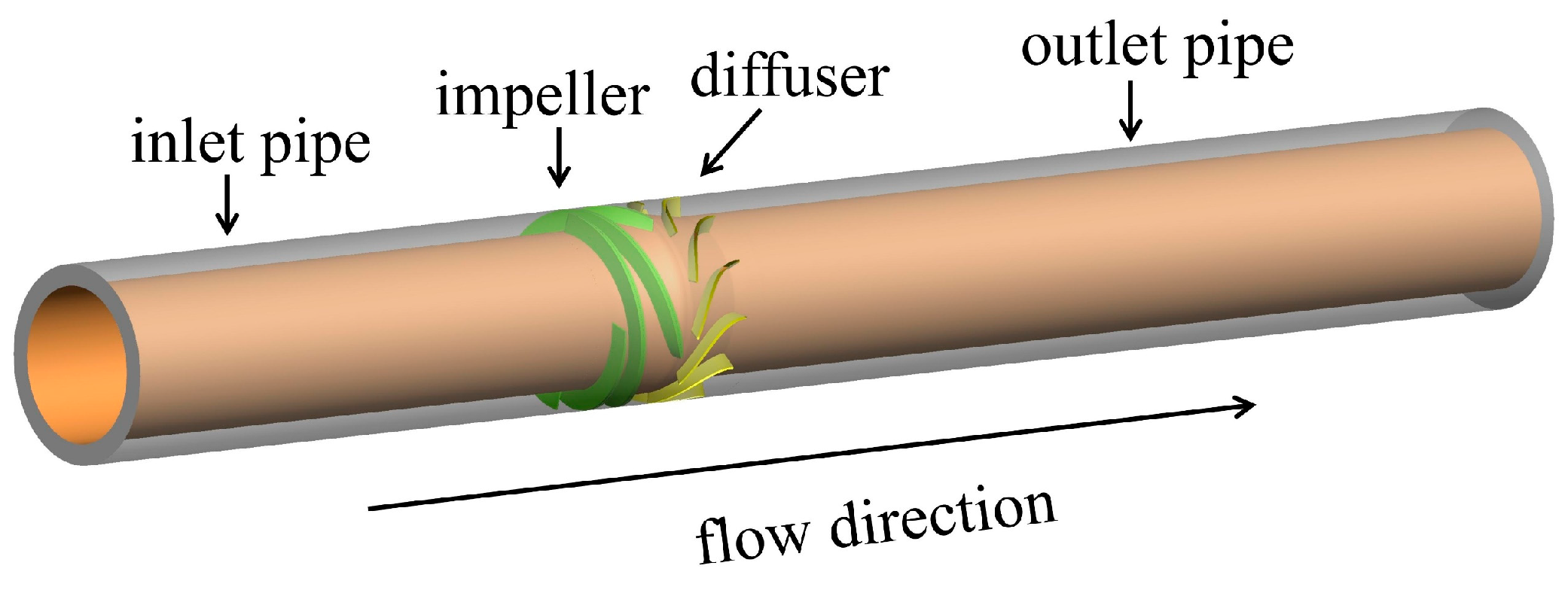


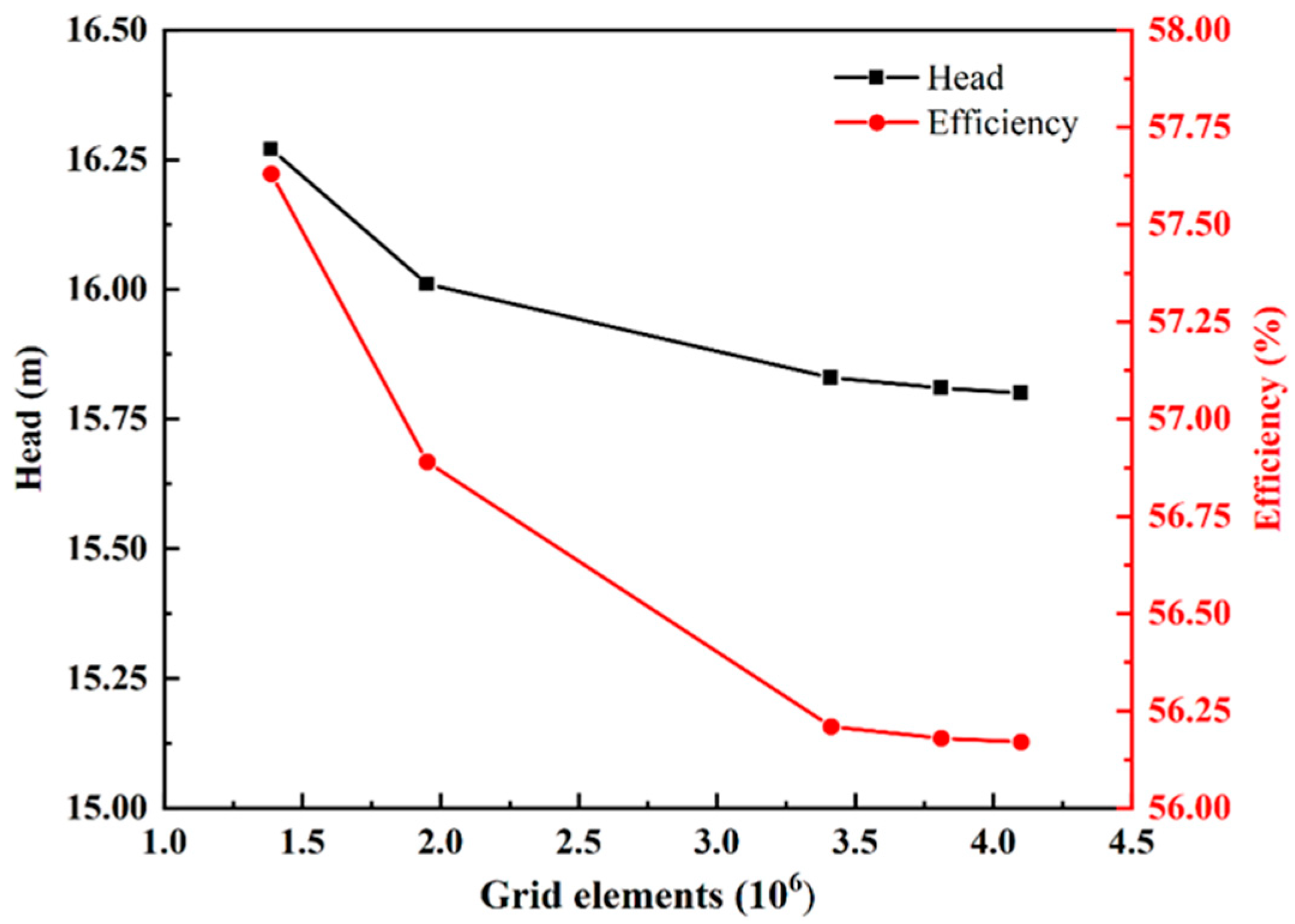
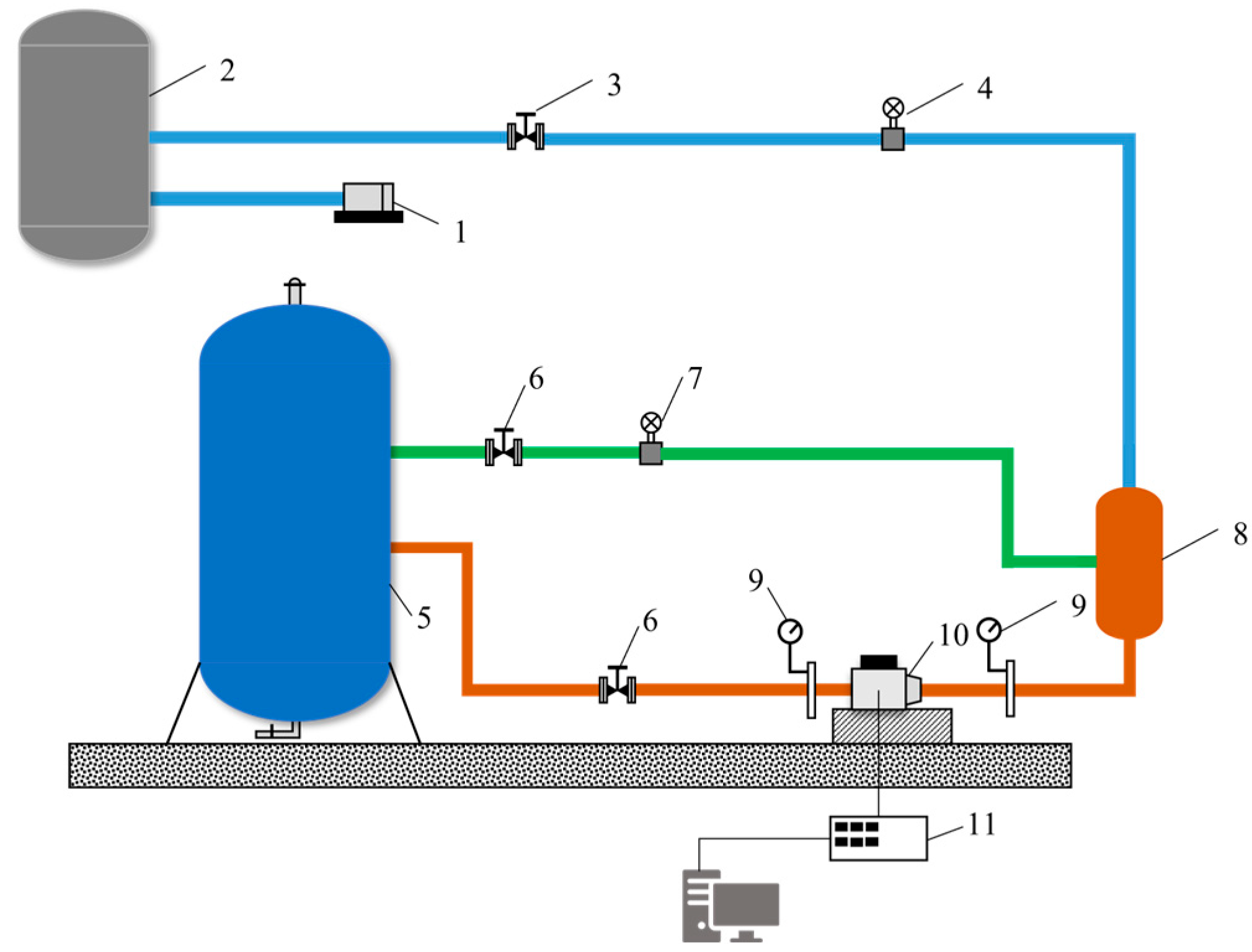
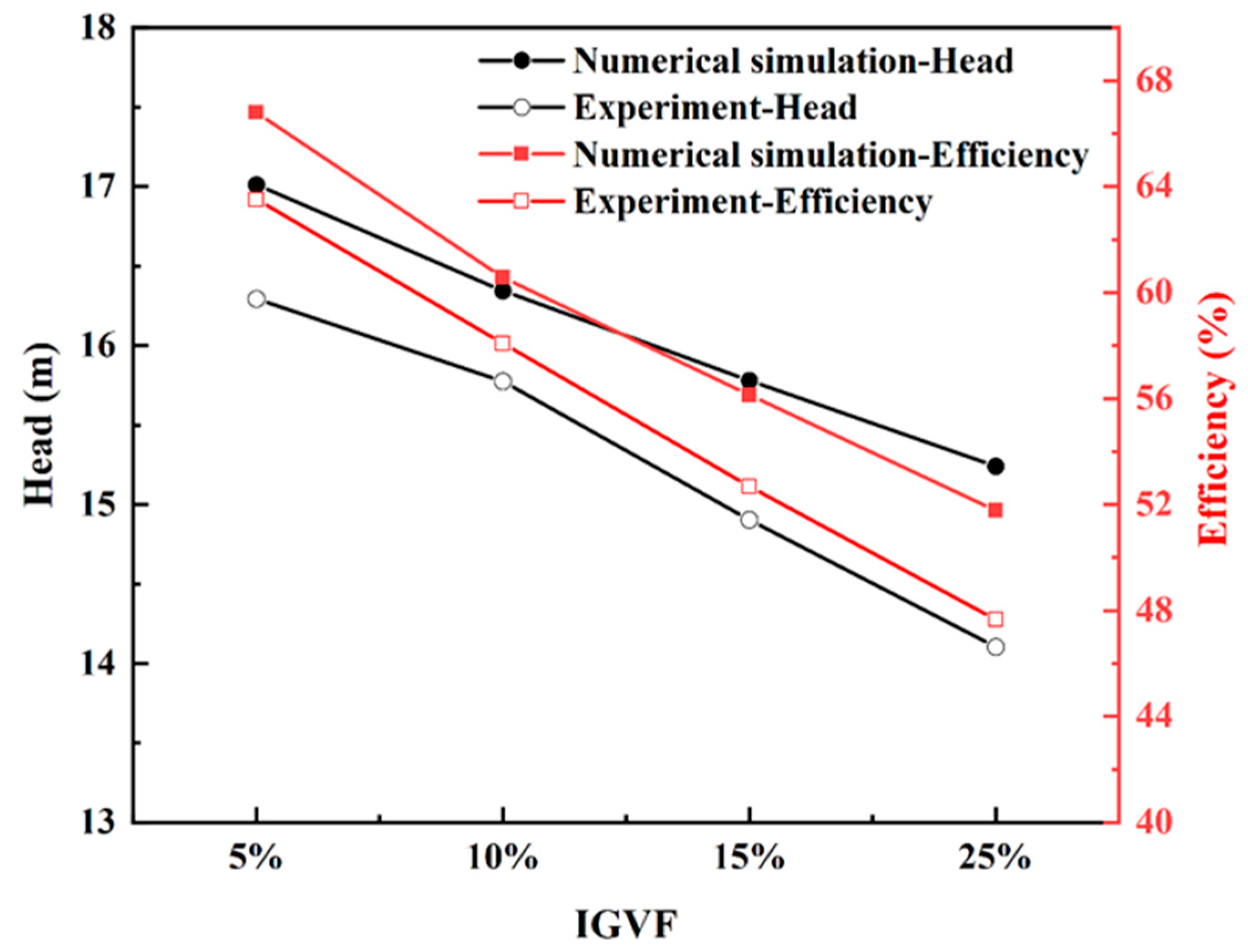
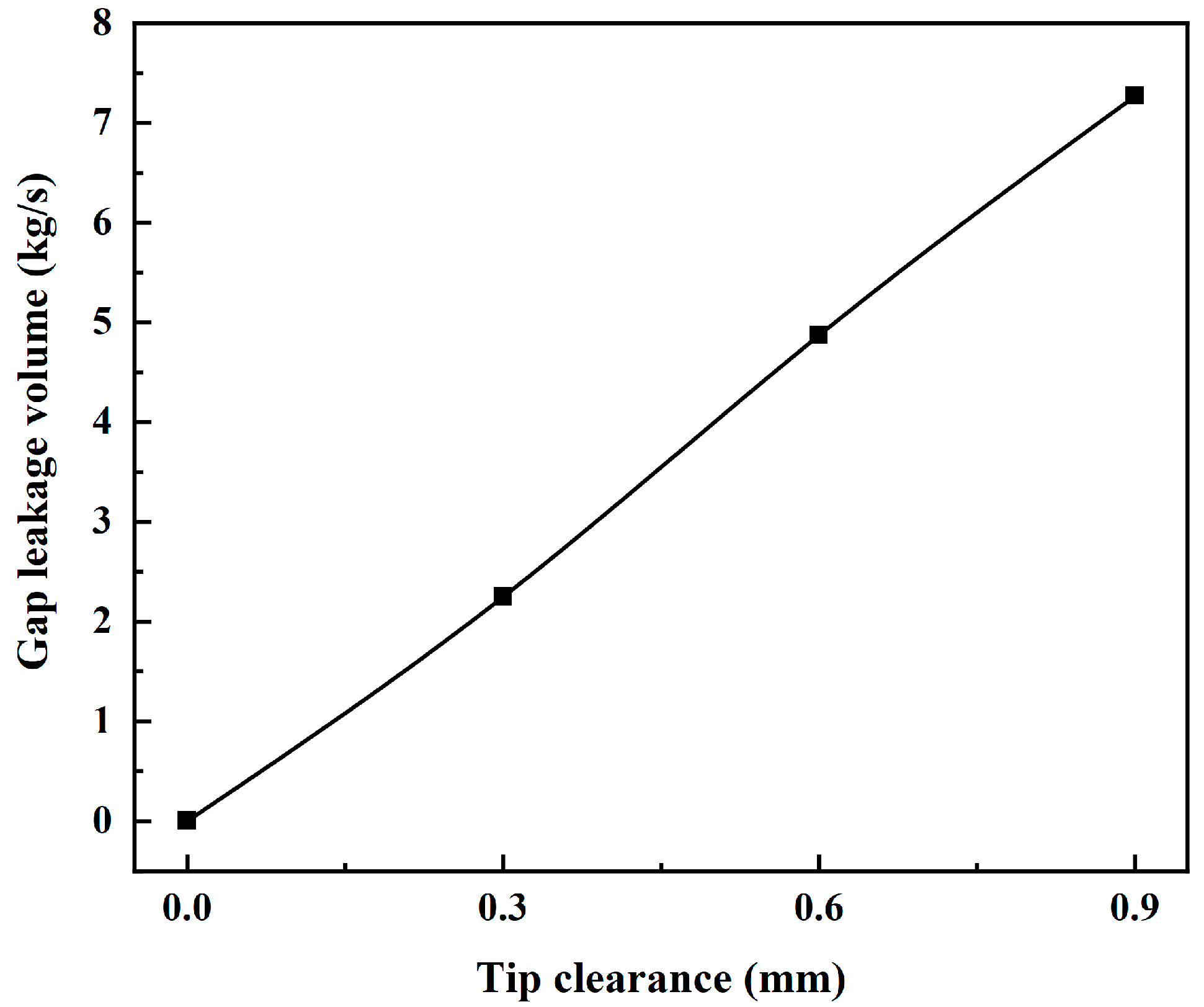


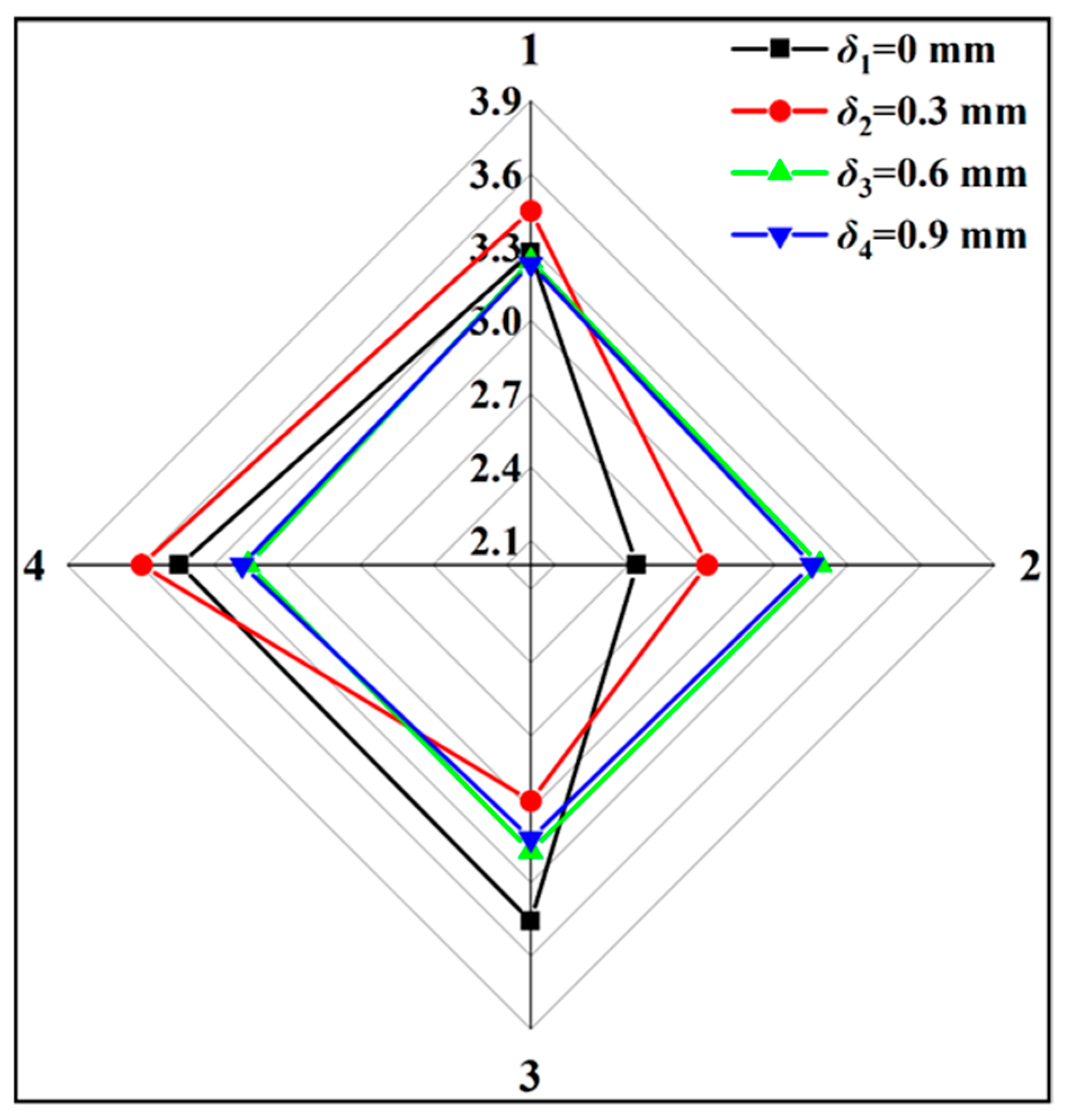
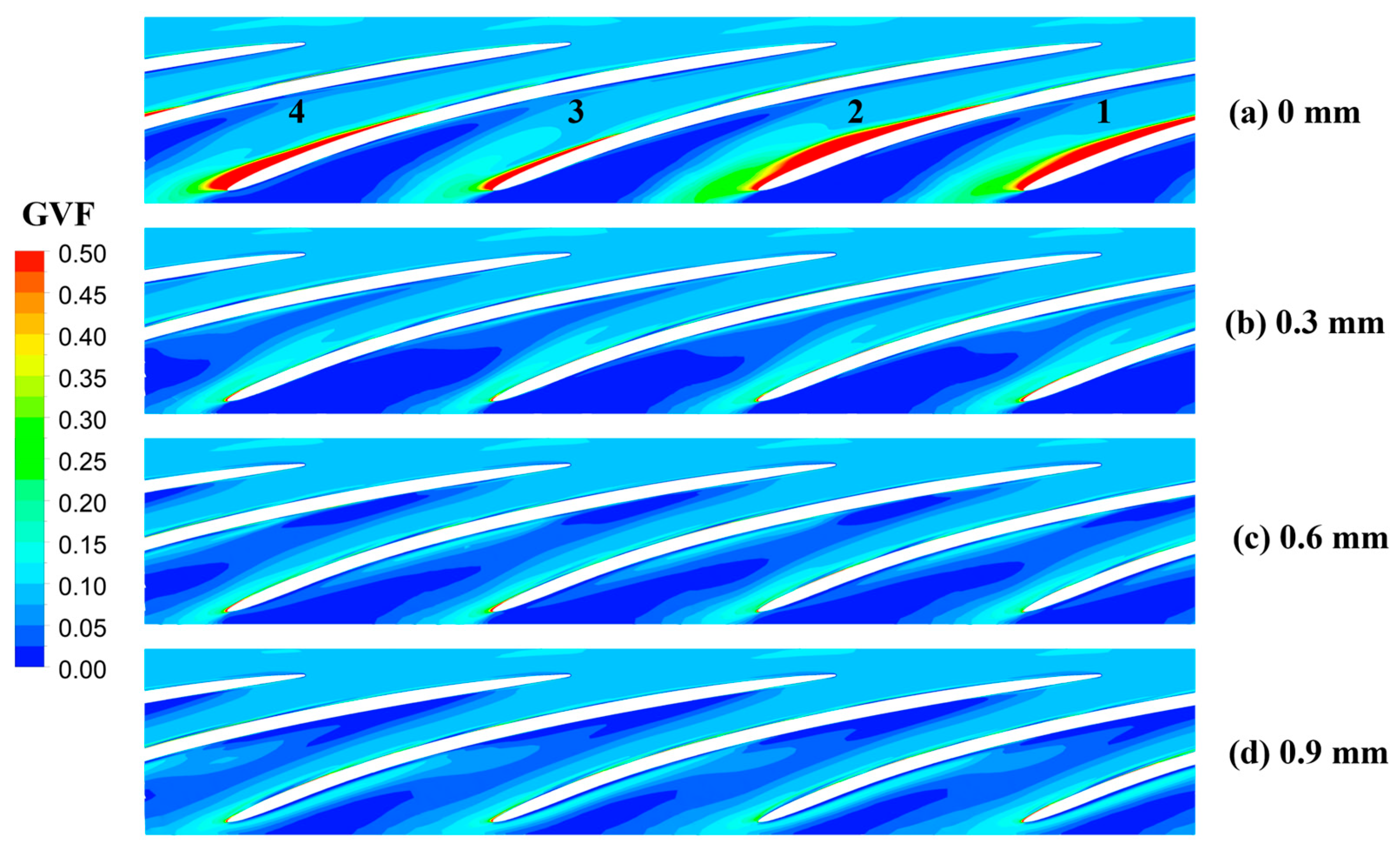
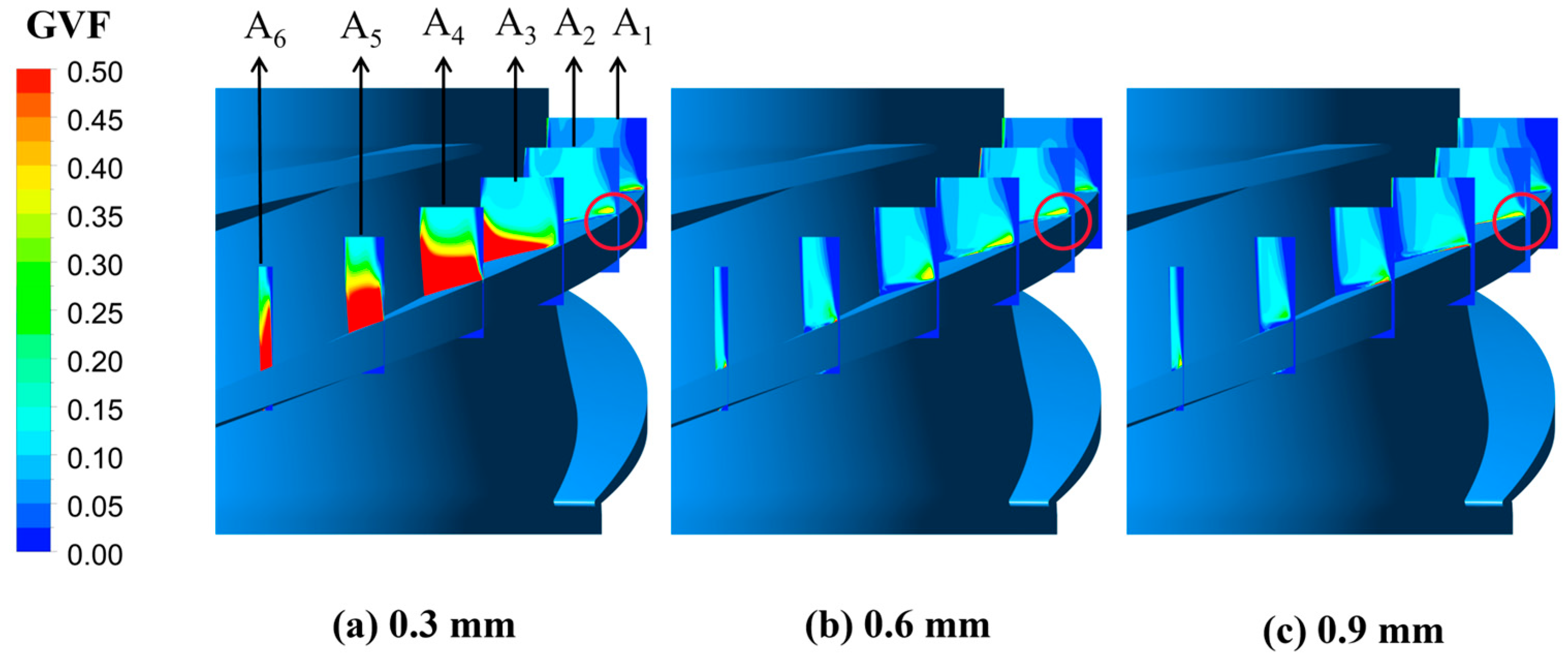
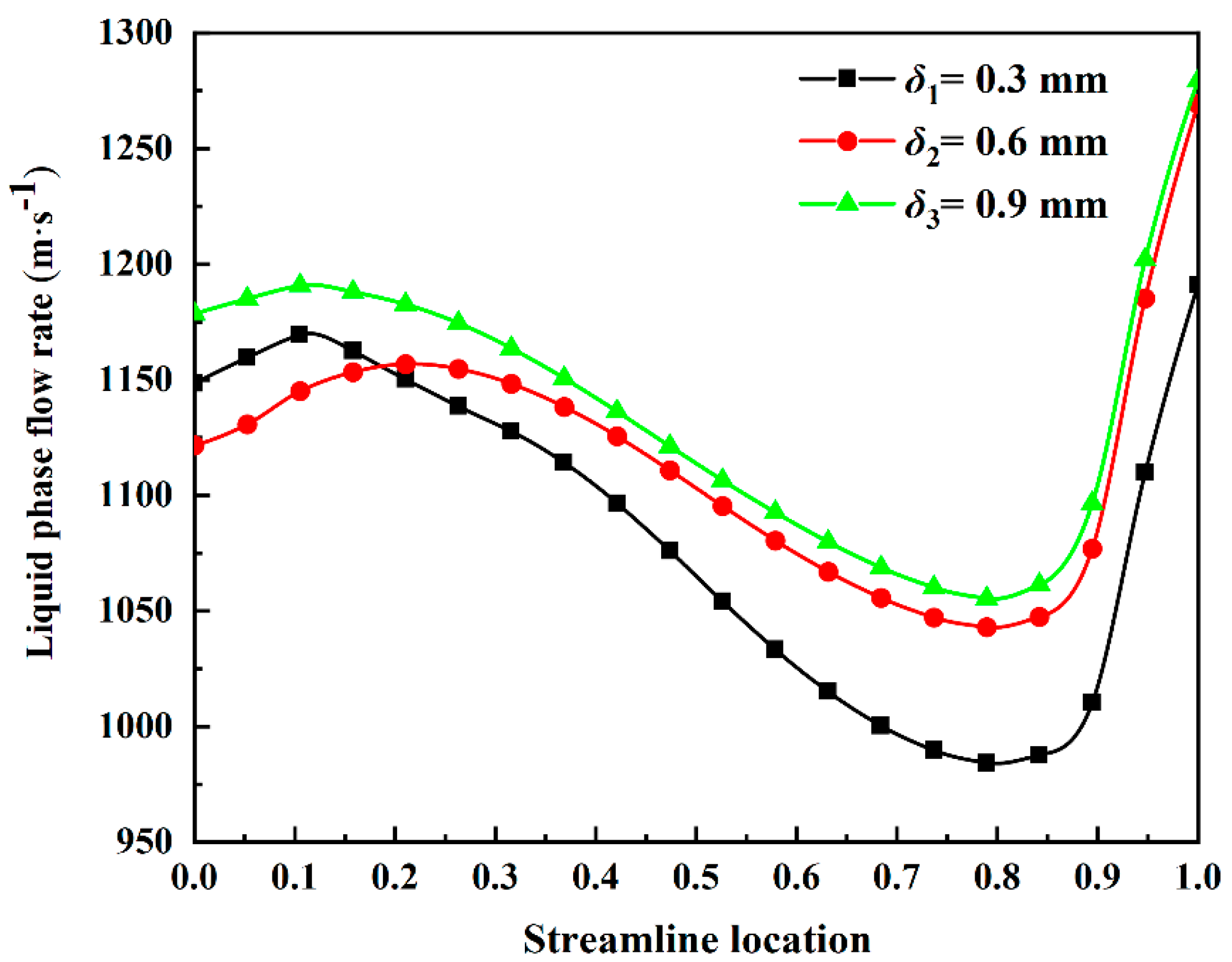
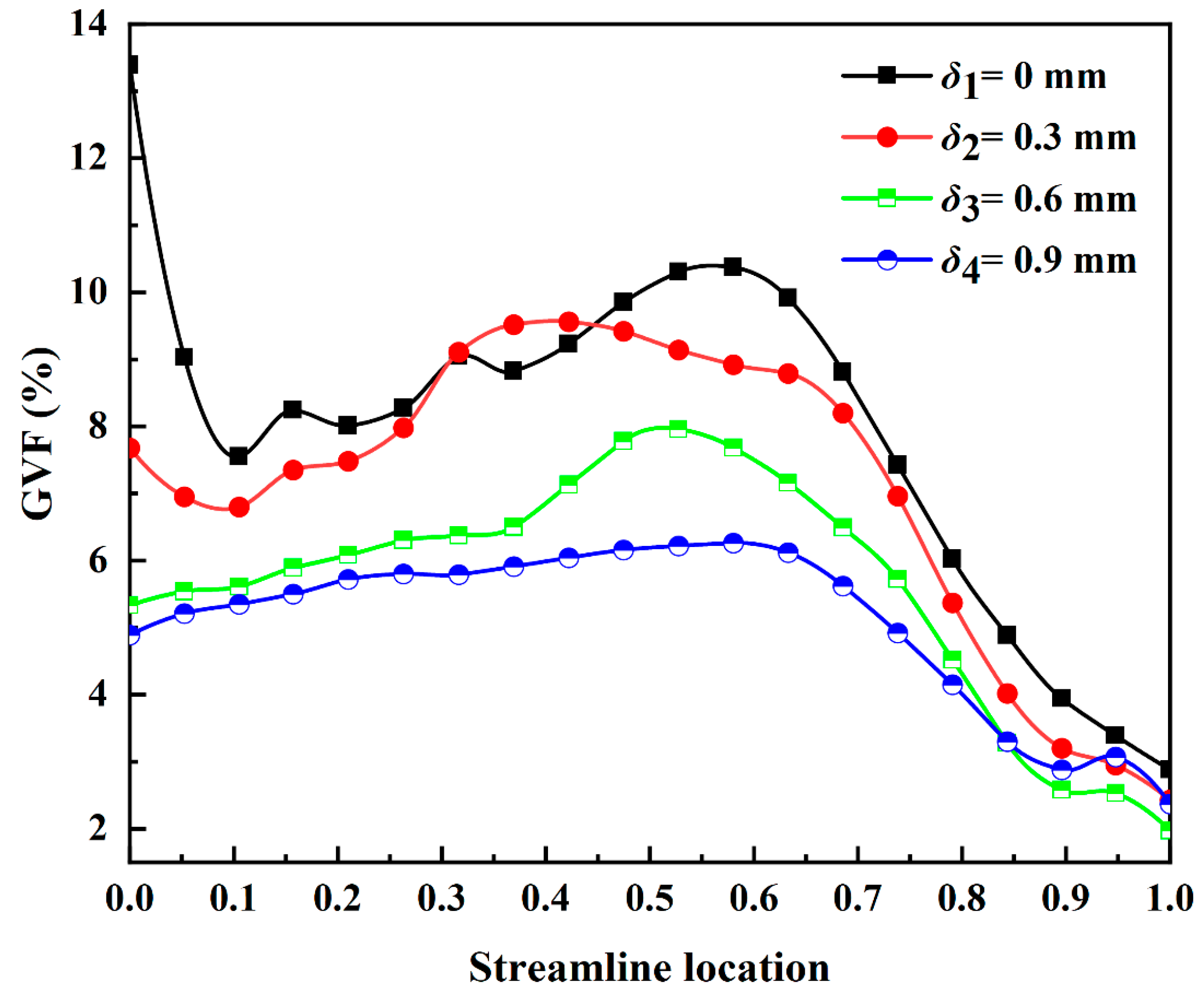
| Parameter | Impeller | Diffuser |
|---|---|---|
| Blade number | 4 | 11 |
| Shroud radius (mm) | 75 | 75 |
| Inlet hub radius (mm) | 58.96 | 67 |
| Outlet hub radius (mm) | 67 | 60 |
| Axial length (mm) | 55 | 65 |
| Tip Clearance (mm) | Head Coefficient (φh) |
|---|---|
| 0 | 0.3023 |
| 0.3 | 0.2968 |
| 0.6 | 0.2926 |
| 0.9 | 0.2877 |
Disclaimer/Publisher’s Note: The statements, opinions and data contained in all publications are solely those of the individual author(s) and contributor(s) and not of MDPI and/or the editor(s). MDPI and/or the editor(s) disclaim responsibility for any injury to people or property resulting from any ideas, methods, instructions or products referred to in the content. |
© 2023 by the authors. Licensee MDPI, Basel, Switzerland. This article is an open access article distributed under the terms and conditions of the Creative Commons Attribution (CC BY) license (https://creativecommons.org/licenses/by/4.0/).
Share and Cite
Deng, Y.; Li, Y.; Xu, J.; Kuang, C.; Zhang, Y. The Influence of Blade Tip Clearance on the Flow Field Characteristics of the Gas–Liquid Multiphase Pump. Processes 2023, 11, 3170. https://doi.org/10.3390/pr11113170
Deng Y, Li Y, Xu J, Kuang C, Zhang Y. The Influence of Blade Tip Clearance on the Flow Field Characteristics of the Gas–Liquid Multiphase Pump. Processes. 2023; 11(11):3170. https://doi.org/10.3390/pr11113170
Chicago/Turabian StyleDeng, Yuxuan, Yanna Li, Jing Xu, Chunyan Kuang, and Yanli Zhang. 2023. "The Influence of Blade Tip Clearance on the Flow Field Characteristics of the Gas–Liquid Multiphase Pump" Processes 11, no. 11: 3170. https://doi.org/10.3390/pr11113170





